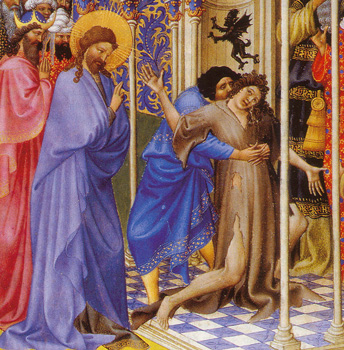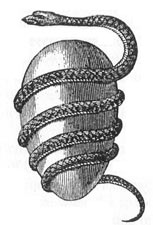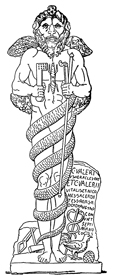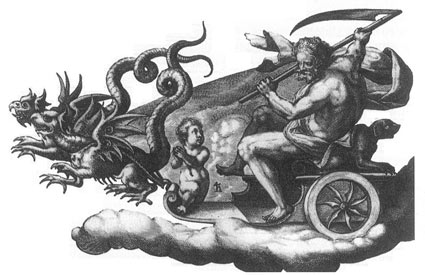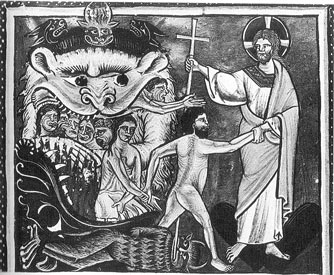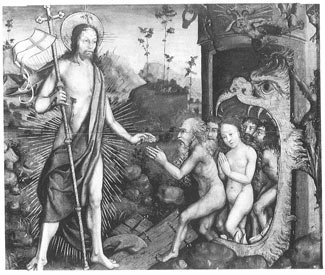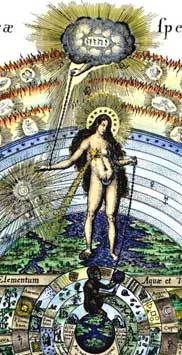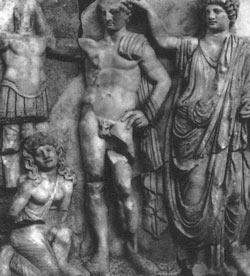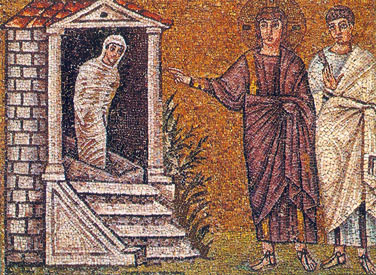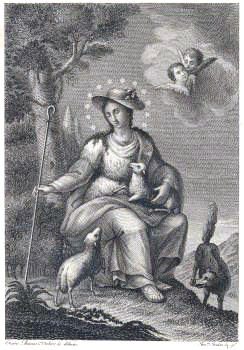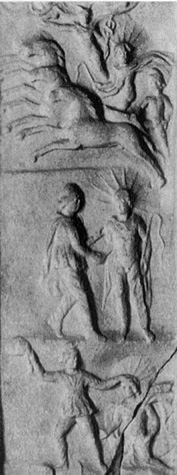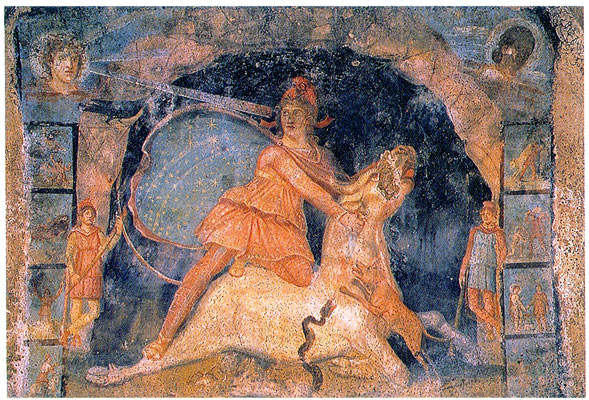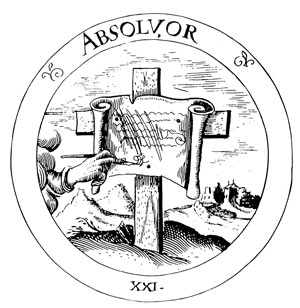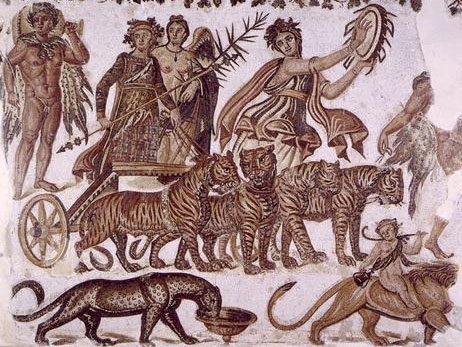The Entheogen Theory of Religion and Ego Death (part 2)
by
Michael Hoffman
September 24, 2006
Salvia Divinorum, Issue 4
(continued from Part 1)
Vertical, Timeless Determinism
Late antique consciousness was centered around the doctrine and mystic-state experience of the pre-setness of future thoughts and occurrences. Heimarmene (Fatedness, Necessity, or timeless cosmic determinism) was the central thematic concern of religions in the Hellenistic era (Martin 1987). Similarly, Philosophical Metaphysics investigates tenseless time, fatedness, agent movement through space and time, and controller agents (Oaklander & Smith 1995).
The future is unchangeable and pre-set because of the static relation of control to the time dimension, and because of the illusory aspect of the continuant agent exercising power while moving through time.
Modern science introduces clockwork determinism and thereby reduces the person to an automaton; Copenhagenist quantum mechanics aims to provide an emancipating alternative to the hidden-variables determinism of Einstein and Bohm, but limits this attempt to intellectual activity and a flowing conception of time that are based in the ordinary cognitive state, unlike the pre-modern approach.
Two Jumps to Transcend Determinism
Determinism is both a praised goal and a disparaged trap to escape, due to determinism-awareness being the intermediate but not final goal of religious mental transformation. Valentinian Gnosticism affirmed cosmic determinism but also transcended it, and formulated two contrasting schemes of thinking about moral culpability (Pagels 1992).
3-stage initiation paths centered around determinism are often posed as 2-stage systems: they both endorse and disparage the realization of determinism, which is the intermediate destination on the path to salvific regeneration. The first demon or stage of egoic delusion to be cast out is the assumption of simple independent self-command and freewill; the second demon to be overcome is the mental model of cosmic determinism or fatedness, in its practical problem-raising aspect.
In Mark 9:14-29, Jesus exorcises the ego-demon from a youth supported by his father; these four figures are aspects of the psyche.
Fatedness and Control in Astral Ascent Mysticism
Heimarmene or universal fatedness was centrally important in ancient astrological cosmology (Barton 1994), and a major theme in Hellenistic-Roman astral ascent mysticism and religion (Cumont 1960). Transcending astral fatedness involved ingesting holy food, ambrosial water, and astrological medicine (Fowden 1986).
Astral ascent mysticism centers around the dangerous gateway or “fatal” boundary crossing – the sphere of the fixed stars – representing the apprehension of Heimarmene and its control of one’s thoughts. The planets wind around the world in a spiral pattern over time, depicted by the Heimarmene-snake wrapped around the cosmos, cosmic egg, or Mithraic lion-headed gatekeeper figure.
Saturn, as governor or gatekeeper of the outermost planetary sphere which is associated with the sphere of the fixed stars, rides in a serpent-drawn chariot and eats the child or youthful self-concept as the price of passage across the boundary into the transcendent heavens beyond the starry Heimarmene-boundary.
Ancient Jewish writings metaphorically describe mystic-state experiences, including the problem of how to get past various threatening gatekeepers that are encountered during ascent (Arbel 2003). Pre-modern Christianity held that the body (lower self) was controlled by Fate, but that the regenerated spirit (higher, ultra-transcendent part of oneself) was above Fate, residing outside the sphere of the fixed stars.
The hidden transcendent thought-source has been depicted as a hand behind a cloud controlling the world-soul whose spirit transcends material Necessity; the world-soul then controls Fate-subject creatures.
Self-Control and the Hidden Source of Thoughts
The ego is the sense of being a metaphysically free, sovereign agent that originates and controls its own thoughts, actions, and movements of the will while moving through time and space.
Ego death is the cessation, in the intense mystic altered state, of the sense and feeling of being a control-wielding agent moving through time, and the replacement of that sensation by the experience of being helplessly, powerlessly embedded in spacetime as purely a product of spacetime, with control-thoughts being perceptibly inserted or set into the stream of thought by a hidden, uncontrollable source.
The Goal of Understanding Ego Death
The promise of increased power over oneself leads to realizing the logical impossibility of that mode of power, but produces instead a viable alternate conception, of secondary-level, reflected power. The vexing attempt to gain properly functioning self-control while holding a confused model of self-control ceases. The misleading sensation of the time-voyaging continuant agent being the originator of the power of will is recognized as a conventional misperception and mental oversimplification.
The Lone Soul in Purgatory shows the soul as imprisoned in chains, purified in flames, and lifted up in redemptive release by transcendent power.
In Gnosticism, the completed initiate belongs to the Immovable Race and is able to stand stably in the face of overwhelming, autonomy-undermining controllership emanating from the hidden, uncontrollable, primary control-level. Insights about the limitations of personal control-power result in a wounding of pride, but the mind is otherwise unharmed, and made more durable (“imperishable”). A personal control system becomes transcendence-compatible or “divinely approved” when it repudiates the assumption that it can depend on its own internal power to save itself during a control-limit violation.
Deliberately Postulating Coming Control-Loss
The ability of one’s immediate self to violate the accustomed desires or will of one’s overall cross-time self, including overriding the accustomed self-preservation restraints, disproves the impression that the time-voyaging continuant control-agent ever was in control as the originator of personal thoughts, and reveals that the true origin of the movements of the will the whole time was a hidden transcendent source other than the self conceived of as a time-voyaging continuant control-agent.
Religious revelation is of our cybernetic control-cancellation potential and the ultimate source of control-power. Deliberately thinking about being helplessly, inevitably, and irresistibly drawn into the thought of near-future loss of control is a way of being drawn up into heaven on Elijah’s whirlwind or fire-chariot.
The Control Breakdown and Transformation Potential
Ever-tighter, more forceful application of rationality that’s premised on the assumption of wielding control-power across time cannot save the control-system from seizure during the disproof of the cross-time phantom-self wielding power over each time-slice self. Testing our control-power and discovering our dependent puppet-like status entails deliberate disproof and self-cancellation of cross-time control, which can threaten to lead to panic attack, self-control seizure, and self-destructive control-chaos.
Relying on one’s conventional power of control-logic and will, when fully developed and perfected, leads to system lock-up – the self-cancellation of personal control power. Demonic reason taken to its full development creates an impossible mess and gets itself tangled up, paralyzed in its own net of reasoning about control, power, and will.
King Pentheus resisted Dionysus, the intruding foreign ruler coming in from outside the kingdom, a mad divine power undermining the ruling power of the local ruler; then king Pentheus was tricked into participating in an ecstatic-state excursion, was lifted and caught up helplessly in a tree, and was defeated and torn to pieces by his mother and other raving Dionysus worshippers.
One’s role as the independent creator and controller of one’s thoughts was an illusion. The current time-slice self or time-voyaging continuant self is helpless to control or restrain the future time-slice selves while playing with the idea of having, keeping, or losing control; the result is like an army of lookalike time-slice selves, fighting against each other.
‘Idol worship’, ‘pride’, or ‘vanity’ is the assumption that the power of egoic control agency is real and substantial, and the futile attempt to depend on that doomed pseudo-power configuration to save oneself from the catastrophic failure of cybernetic self-control, which is inherently, systemically entailed.
Julius Caesar was considered authorized for power by his seizures, and the bull in his military’s Mithraic mystery-cult was wounded in the side, so the figure of Jesus was shown as similarly authorized by the spear-wound in his side, and the figure of the apostle Paul was portrayed as suffering from seizures. The ability to make self-control seize or cancel itself dramatically is an afflicting thorn (2 Cor. 12:7-10), hole, or wound in our side, the innate cybernetic governance-failure through which the new, transformed life is born. The new transcendence-aware self is given birth through the pride-killing disproof-wound in the side.
Transcendent Solution to Restoring Viable Control
A different approach and solution is required, to restore order from the chaos of self-dependence that’s based on incoherent premises, to provide a more robust basis than reliance on personal power wielded by the semi-illusory conventional self. Something that transcends personal control-power logic is needed to provide an alternative to the seized, useless logical scheme of egoic control power. After being shown this cybernetically fatal potential, a rescuing miracle of transcendent magic arrives from outside the system of egoic control-power logic.
The mind’s transcendent potential kicks in, realizing that the logic of control-agency power originated by the phantom self cannot be the solution to the very problem that such an inaccurate configuration generated in the first place; one must put one’s reliance on a self-existing faith, compassion, heart, love, or benevolent Holy Spirit, which cannot have any ordinary rational control-logic basis and that one does not experience as a product of one’s own egoic control-power or will, but is consciously experienced as being given by the hidden source of thoughts.
Solving the problem of true and justified mental order of personal self-government instead of control-chaos comes through a transcendent Zen jump. Depending on the egoic system of reasoning, which is constructed around inherently self-frustrating premises, ultimately leads to control lock-up and a catastrophically ineffective self-cancellation of control. Buddha recognized that his destiny was to touch the ground in an act of compassion and harmonious integration with the unity of the Ground of Being, causing Mara and his army of demons to instantly disperse – then he experienced enlightenment.
Viable and coherent control is provided by recognizing that personal control depends on transcendent givenness of your thoughts by a mysterious hidden source that ultimately caused the control lock-up and independently saves your controllership, restoring it in a newly coherent form. The hidden source of thoughts that provides a viable, transcendent personal control system is personified as a merciful and compassionate God.
The figure of Caesar was plugged into the routinized mystery-cult format utilizing ‘mixed wine’; these imperial-government themed mystery cults had initiation rites for mystai using ‘mixed wine’ heavily, along with symposium drinking parties (Pleket 1965). These imperial mystery cults incorporated themes of ending civil war to bring cooperation and prosperity among the former factions; defeat of rebellious nations, pardon upon sacrifice to Caesar, then incorporating them harmoniously into Caesar’s peaceful empire; and restoration of stable government by the divine higher-level ruler, with Caesar as Jupiter’s representative.
Our control-power has the Judas capability – the ability to betray the illusory position of power, through divine, transcendent power-seizure, and thereby deliver our lower, “rebellious” claim of independent kingship-power over to the transcendent level of governing power.
In John 11, Lazarus is transcendently lifted up from ego-death control-power paralysis by Jesus as the representative of the separate, higher-level source of thoughts. Jesus told his disciples “Lazarus is dead, and for your sake I am glad I was not there, so that you may believe. But let us go to him.” Then Thomas (called Didymus, the twin) said to the rest of the disciples, “Let us also go, that we may die with him.”
Maria the Divine Shepherdess of Souls, Divina Pastora, as benevolent and trustworthy thought-provider rescues and protects the person from the direly threatening wolf, which is the threat of loss of control or hostile control-usurpation by the hidden thought-source. After transcendently being moved out from the doomed system of pseudo-independent personal control logic, one experiences the joyful sense of relief and thankfulness of having been rescued from certain peril from outside the resources one wields as a local locus of control and a time-voyaging continuant control-agent.
Sin as Misattribution of Control-Thoughts
Upon initiation, the concept of ‘sin’ is reinterpreted and revised, producing a transformed mental model which understands ‘sin’ to be a logical error about the nature of control-agency and agent-culpability. Sin is a matter of understanding and meaning-shift. The secret of the kingdom of God has been given, but cloaked in double-meanings so that those on the outside may see and hear but not understand, lest they turn about and their sins be forgiven (Mark 4:12).
In mystic metaphor, misunderstanding moral agency is considered the fundamental sin and immorality; God was most angry about the king’s rebellious worship of idols that are fashioned out of created materials – a metaphor for taking pseudo-autonomous personal control-agency as though it were genuinely autonomous. Reformed theology affirms the predestination of who God gives salvific grace to, while holding to the moral culpability of created persons – this Augustinian compound model is a bi-modal, metaphorical meaning-shifting technique, rather than a simply inconsistent combination of beliefs.
A person’s will appears to be originated and controlled by the time-voyaging continuant agent that’s projected out from each time-slice along the person’s timelessly frozen worldline; the conception of personal control agency that is built around this illusion is ‘sin’ and the ‘lie’.
Wrath, Compassion, and Making Peace
‘Wrath’ means the threat that Fate or blind, machine-like determinism is ultimately in control of your coming thoughts but is set against your claim to exert independent power over your thoughts.
Mystic-state ‘compassion’ and ‘rescue that narrowly averts divine wrath’ means that that which ultimately gives you your thoughts is intimately united with you and is good or benevolent toward you, bringing you into a harmonious, reconciled, integrated relationship with the compassionate and beneficent controller of all that happens, including your own near-future thoughts.
The wrath/compassion polarity is portrayed as paired deities of wrath and compassion in Tibetan Buddhism; dual traits of the Creator (justice and mercy); and Jesus as harsh righteous judge with Mary as compassionate intercessor. The god of battling and the goddess of love – Ares and Aphrodite (Mars and Venus) – were caught together in a near-invisible net, producing the child Harmonia (Concordia).
Jupiter Optimus Maximus means ‘all-good’ and ‘all-powerful’, as is hoped for from a protective deity when one is vulnerable to awareness of Heimarmene in the intense mystic altered state.
Mithras demonstrates that his arm wields control over the power of the bull’s shoulder. Sol is reconciled with Mithras in a pact, and given transcendent power. Sol becomes an authorized charioteer, steering the quadriga with Mithras, guided by Mercury (Hermes) holding a Fatedness-snake on a time-pole.
Sacrificing to End Battling the Thought-Source
‘Sacrifice’ is a mental attitude of cooperative dependence on that which gives thoughts, your will having been overcome and made to will its own demise as an empty delusion, turned against itself by now-revealed transcendent power. Sacrifice offers up and hands over your claim to effective independent power, as opposed to battling against your near-future self and the inherently overpowering source of all thoughts and movements of will.
Sacrificing your autonomy-claim, acknowledging your dependency on that which ultimately gives you your thoughts, brings mental peace and harmony and calms turmoil, because you are relieved from increasing your attempt to grasp and secure power over your own power; relieved from testing the power of your autonomy and the limits of your self-control thoughts.
Roman sacrificial altars are typically shown with a libation of concentrated, psychoactive unmixed wine being poured on the altar, which opens up a channel to the gods, along with the sacrificial animal such as the unresisting, cooperative bull. The sacrificer pouring the libation has a cloth behind the head, representing the spiritual ecstatic state, where awareness is positioned outside of the usual mind, perceiving its functioning.
Mithras overpowering and sacrificing the bull represents the delusion of self-originated control-power being given over to the transcendent level, with Mithras’ arm wielding the bull’s shoulder and his knife piercing and fatally wounding it; the wound in the bull’s side indicates Mithras demonstrating his power over the bull’s control-power. Mithras wrestles and overpowers the initiate’s control of their will, reconfiguring their understanding of control-power to account for the transcendent givenness of one’s thoughts.
Sol represents the mind’s awareness, which in the dissociative state is positioned ecstatically outside the mind’s functioning. The mind is possessed and overtaken by Mithras. Pure awareness passively watches the sacrificial disproof of the mind’s claim to wield independent personal control-power.
A tauroctony shows: the self-command bull being sacrificed near the shoulder; a Heimarmene-snake inevitably drawn toward ingesting the entheogenic blood (often the snake approaches a wine-mixing bowl below the bull instead); a blue-stemmed Psilocybe mushroom in Mithras’ leg and garment with 7-stepped stem; the sphere of the fixed stars shown inside the underworld cave; a billowing cape behind Mithras indicating the ecstatic state; the god making the bull paralyzed and unable to stand; Mithras’ feminine features indicating the soul abducted and married by divine power; and Mithras turning to knowingly look back behind the conventional self-concept to see the source of thoughts and movements of the will.
Vertical Atonement for Rebellion-Guilt
Vicarious atonement entails a vertical shift upward of guilt and responsibility to a higher-level controller, not a horizontal shift sideways to a morally better person. A vertical 2-level legal and moral relationship applies to all controller/agent scenarios: master/slave, commander/soldier, potter/clay, puppetmaster/puppet, creator/creature, and virtual-world creator/virtual agent.
Releasing a prisoner who is a rebel slave (claimant to autonomy), and punishing a mock king in their stead by death sentence, is found in the Roman Saturnalia and in the mystic allegory of Jesus’ trial; the rebel Barabbas (son of father) is released.
The Jesus figure was portrayed in the New Testament as the earthly representation and manifestation of the all-powerful and all-controlling Jewish creator God (Thompson 2001). Jesus is held to be innocent in the sense of not himself rebelling against God (that is, he never mistook the pseudo-autonomy of personal control-agents as literal autonomy), but being the Creator’s representative figure within the created world, he was ultimately responsible or guilty for all instances of such ‘rebellion’ which did occur by other people.
Lucifer fell from heaven, as Adam fell, due to pride through the virtual power of his virtual free will. Justice consistent with this metaphorical meaning-mode requires that he suffer a virtual death-sentence for his rebellious autonomy-claim; this sin is “punished” in the appropriate sense through mystic-state ego death and thereby done away with. Justice about ultimate responsibility is thereby fulfilled, and the initial, youthful error about our independent self-command corrected.
The Sacred Marriage
The sacred marriage or pact with the divine provides a transcendent personal control system that is viable and stable; is based on mature, refined understanding about personal control agency instead of misperception and frustrating confusion; and integrates one’s mundane-realm personal control activity with the transcendent realization that thoughts originate from outside one’s realm of control.
In the ancient Greek tradition, marriage incorporated the themes of abduction and death of the girl, together with entheogenic initiation (Ruck 1978); similarly, Christ raptures-away and marries his Church, the initiated elect, as his bride.
Dionysus and the abducted/married soul, Ariadne, ride in Dionysus’ victory procession, in a chariot drawn by four mushroom-tigers.
The uncontrollable hidden separate controller abducts and overtakes your innermost locus of control-power, as though that innermost wellspring of your thoughts is your generative organ and ego death is climax, giving birth to the new self that is married to the higher controller. The sacred marriage of hidden and visible levels of control, producing new life, is celebrated in the wedding banquet with entheogenic mixed wine.
Bibliography
Michael
Hoffman has been developing the Cybernetic Theory of Ego Transcendence since
1985, including the maximal entheogen theory of religion; see Egodeath.com.
Arbel, V. Beholders
of Divine Secrets: Mysticism and Myth in the Hekhalot and Merkavah Literature.
Ashton, J. The
Religion of Paul the Apostle.
Balsekar, R. Who
Cares? The Unique Teaching of Ramesh S. Balsekar.
Barton, T. Ancient
Astrology.
Bryan, C. Render
to Caesar: Jesus, the Early Church, and the Roman Superpower.
Collins, J. J. (editor), and M. Fishbane (editor). Death, Ecstasy, and Other Worldly Journeys.
Culiano,
Cumont, F. Astrology
and Religion among the Greeks and Romans.
Davies, S. Jesus
the Healer: Possession, Trance, and the Origins of Christianity.
Detering, H. Der
Gefälschte Paulus; The Fabricated Paul: Early Christianity in the Twilight. Düsseldorf:
Doherty, E. The
Jesus Puzzle: Did Christianity Begin with a Mythical Christ? Challenging the
Existence of an Historical Jesus.
Drews, A. Die
Petruslegende; The Legend of Saint Peter: A Contribution to the Mythology of
Christianity.
Fishbane, M. The
Kiss of God: Spiritual and Mystical Death in Judaism.
Forte, R. (editor). Entheogens and the Future of Religion.
Fowden, G. The
Egyptian Hermes: A Historical Approach to the Late Pagan Mind. Princeton:
Freke, T.; and P. Gandy. The Complete Guide to World Mysticism.
Grof, S. (editor), and C. Grof (editor). Spiritual Emergency: When Personal
Transformation Becomes a Crisis.
Grof, S.; and C. Grof. Beyond Death: The Gates of Consciousness.
Heinrich, C. Strange
Fruit: Alchemy and Religion: The Hidden Truth.
Hoffman, M. A. (editor). Entheos: The Journal of Psychedelic Spirituality. Entheomedia.org,
2001-2002.
Hoffman, M. A., C. A. P. Ruck, and B. Staples. “The
Entheogenic Eucharist of Mithras”. Entheos
2.1:13-46 (2002).
Hoffman, M. “Wasson and Allegro on the Tree of
Knowledge as Amanita”. Journal of Higher Criticism, forthcoming,
2006.
Hoffman, M. “The Bubble of Simulation: Subjective
Experience as a Virtual Environment”. Crash
Collusion 10:21-22, 1996.
Hofmann, A.; R. E. Schultes; and C. Ratsch. Plants of the Gods: Their Sacred, Healing
and Hallucinogenic Powers.
Johnson, L. T. Religious
Experience in Earliest Christianity: A Missing Dimension in New Testament
Studies.
Kubby, S. The
Politics of Consciousness: A Practical Guide to Personal Freedom. Port
Townsend: Loompanics, 1995.
Martin, L. H. Hellenistic
Religions: An Introduction.
Merkur, D. Gnosis:
An Esoteric Tradition of Mystical Visions and Unions.
Merkur, D. The
Psychedelic Sacrament: Manna, Meditation, and Mystical Experience.
Metzner, R. The
Unfolding Self: Varieties of Transformative Experience.
Nasrallah, L. An
Ecstasy of Folly: Prophecy and Authority in Early Christianity.
Oaklander, L. N. (editor), and Q. Smith (editor). The New Theory of Time.
Oaklander, L. N., and Q. Smith. Time, Change and Freedom: An Introduction to Metaphysics.
Pagels, E. The
Gnostic Paul: Gnostic Exegesis of the Pauline Letters.
Pleket, H. W. “An Aspect of the Emperor Cult:
Imperial Mysteries.” Harvard Theological
Review 58:331-47 (1965).
Pilch, J. J. Visions
and Healing in the Acts of the Apostles: How the Early Believers Experienced
God. Collegeville: Liturgical, 2004.
Ruck, C.; B. Staples; and C. Heinrich. The Apples of Apollo: Pagan and Christian
Mysteries of the Eucharist.
Rucker, R. The
Fourth Dimension: A Guided Tour of the Higher Universes.
Russell, D. Shamanism
and the Drug Propaganda: Patriarchy and the Drug War.
Shanon, B. The
Smith, D. E. From
Symposium to Eucharist: The Banquet in the Early Christian World.
Taylor-Perry, R. The
God Who Comes: Dionysian Mysteries Reclaimed.
Thagard, P. Conceptual
Revolutions. Princeton:
Thompson, M. M. The
God of the Gospel of John.
Ulansey, D. “The Eighth Gate: The Mithraic
Lion-Headed Figure and the Platonic World-Soul”. Forthcoming; online.
Vernant, J-P.; and P. Vidal-Naquet. Myth and Tragedy in Ancient
Wasson, R. G.; A. Hofmann, and C. Ruck. The Road to
Wegner, D. White
Bears and Other Unwanted Thoughts: Suppression, Obsession, and the Psychology
of Mental Control.
White, R. Nietzsche
and the Problem of Sovereignty.
Williams, M. A. The
Immovable Race: Gnostic Designation and the Theme of Stability in Late
Antiquity.
Copyright
© 2006 Michael
Hoffman. All rights reserved.
